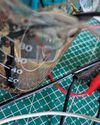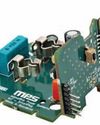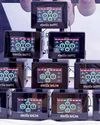DTMF: The Evergreen Retro Tech
Electronics For You
|January 2023
This article looks at how DTMF technology has evolved over the years, and can still be of use

In the days of analogue telephone communication, the most common type of cable that was used for connectivity was the unshielded twisted pair (UTP). Since it did not have a physical shield to block any interference, the amount of interference was a bit high. However, it was not too noisy and was good enough to transmit voice. But as the days passed and the number of people using telephones increased, the need for an automated telephone exchange increased too. It was in January 1958 that G. Goertzel published a paper called 'An Algorithm for the Evaluation of Finite Trigonometric Series, in the American Mathematical Monthly. This became the basis of dual tone multiple frequency (DTMF) signalling. It allowed us to encode numeric values as superpositions of two co-prime sine waves in such a way that they became noiseresistant.
On November 18, 1963, Bell Systems introduced phones with buttons instead of rotary dials. DTMF assigned a special tone to each button pressed on the telephone device. As a number was dialled, each button that was pressed gave a standard audio signal. The telephone exchange could decode these signals as DTMF to find out what number the user had typed in.
Binary was defined by 'on' and 'off' or '1' and '0'. DTMF technology worked by having the handset generate tones at specific frequencies and playing them over the phone line when a button was pressed on the keypad. It could be treated like a device to switch up to eight appliances. Equipment at the other end of the phone line listened to the specific sounds and decoded them into commands.
Denne historien er fra January 2023-utgaven av Electronics For You.
Abonner på Magzter GOLD for å få tilgang til tusenvis av kuraterte premiumhistorier og over 9000 magasiner og aviser.
Allerede abonnent? Logg på
FLERE HISTORIER FRA Electronics For You

Electronics For You
Tech Majors Are Racing TOWARDS NET-ZERO - What About You?
Apple, Microsoft, Amazon, Google, Infosys, Wipro—global and Indian firms are heading closer to achieving net-zero emissions, a mandate to combat climate change. Here is what you need to know to start your journey...
12 mins
December 2025

Electronics For You
Miniature IoT WATER TDS And LEVEL MONITOR Cum CONTROLLER
For setups that rely on stored water, clear awareness of tank level and water quality is essential.
3 mins
December 2025

Electronics For You
The Impact Of GENERATIVE AI On The Future Of AUTOMOTIVE AND EVs
Autonomous vehicles, connected ecosystems, and smart factories are only the beginning. Generative Al is pushing the auto industry beyond predictions into a bold era of creativity-from EV design to real-time diagnostics and showroom automation. Here is how GenAl is reshaping innovation across the automotive value chain.
8 mins
December 2025

Electronics For You
How AI Tools Are Making SOFTWARE DEVELOPMENT BETTER
AI is reshaping how we code, debug, and collaborate. From Copilot to automation, it is changing software development in ways worth exploring.
3 mins
December 2025
Electronics For You
How AI Tools Are Making SOFTWARE DEVELOPMENT BETTER
AI is reshaping how we code, debug, and collaborate. From Copilot to automation, it is changing software development in ways worth exploring.
3 mins
December 2025

Electronics For You
5 Interesting Reference Designs FOR SMART HOMES
Smart home devices are transforming the way people interact with their appliances. They make homes more convenient, secure, and energy-efficient. From smart plugs and energy monitors to smart locks and thermostats, reference designs help design engineers create connected products that are easy to use, consume less power, and are reliable. These designs allow you to control devices remotely, track energy use, extend battery life, and automate routines. They provide practical solutions for upgrading homes and small commercial spaces without major modifications.
3 mins
December 2025

Electronics For You
Fancy USB LED VASE
This USB LED vase is a simple yet elegant device that fuses art with electronics to create a decorative lighting display. Powered directly from a standard USB port, it uses readily available components such as MOSFETs, resistors, capacitors, and LEDs to produce a striking, dynamic sequence of lights.
3 mins
December 2025

Electronics For You
"WHAT OTHERS SELL IN FOUR BOXES WE BUILT IN ONE"
Years of custom field work are shaping a product line with its own cloud, its own hardware, and a market that is now beginning to recognise its value.
8 mins
December 2025

Electronics For You
BUILD LARGE LANGUAGE MODELS
Large language models are machine learning models designed for a range of language-related tasks such as text generation and translation. Here’s how open source software can help you build your own large language model.
6 mins
December 2025

Electronics For You
Rare Earth Or Rare Ingenuity? India Remains Between The Two
With China firmly controlling rare earth exports, India confronts a critical moment in its technological trajectory.
8 mins
December 2025
Translate
Change font size

